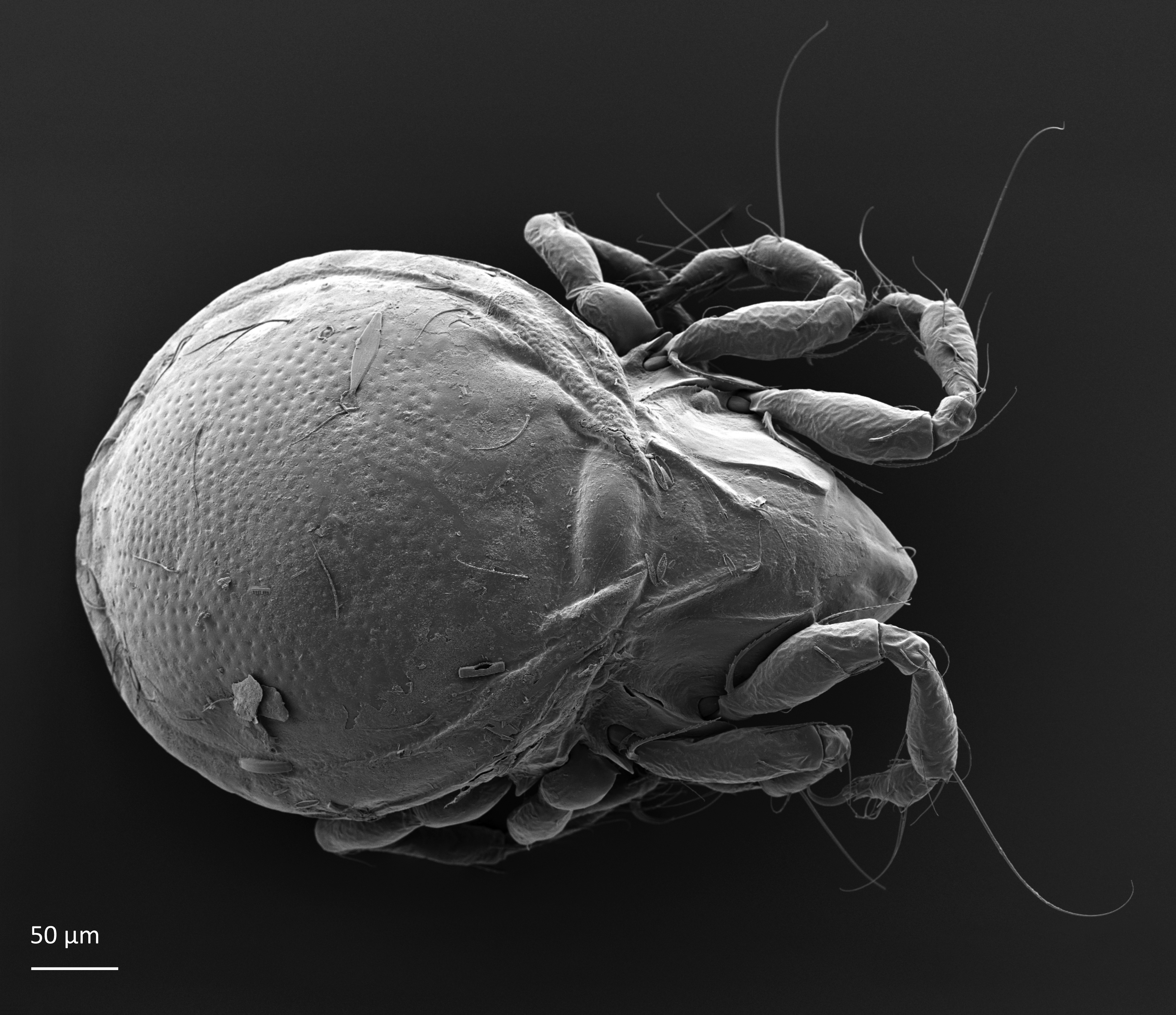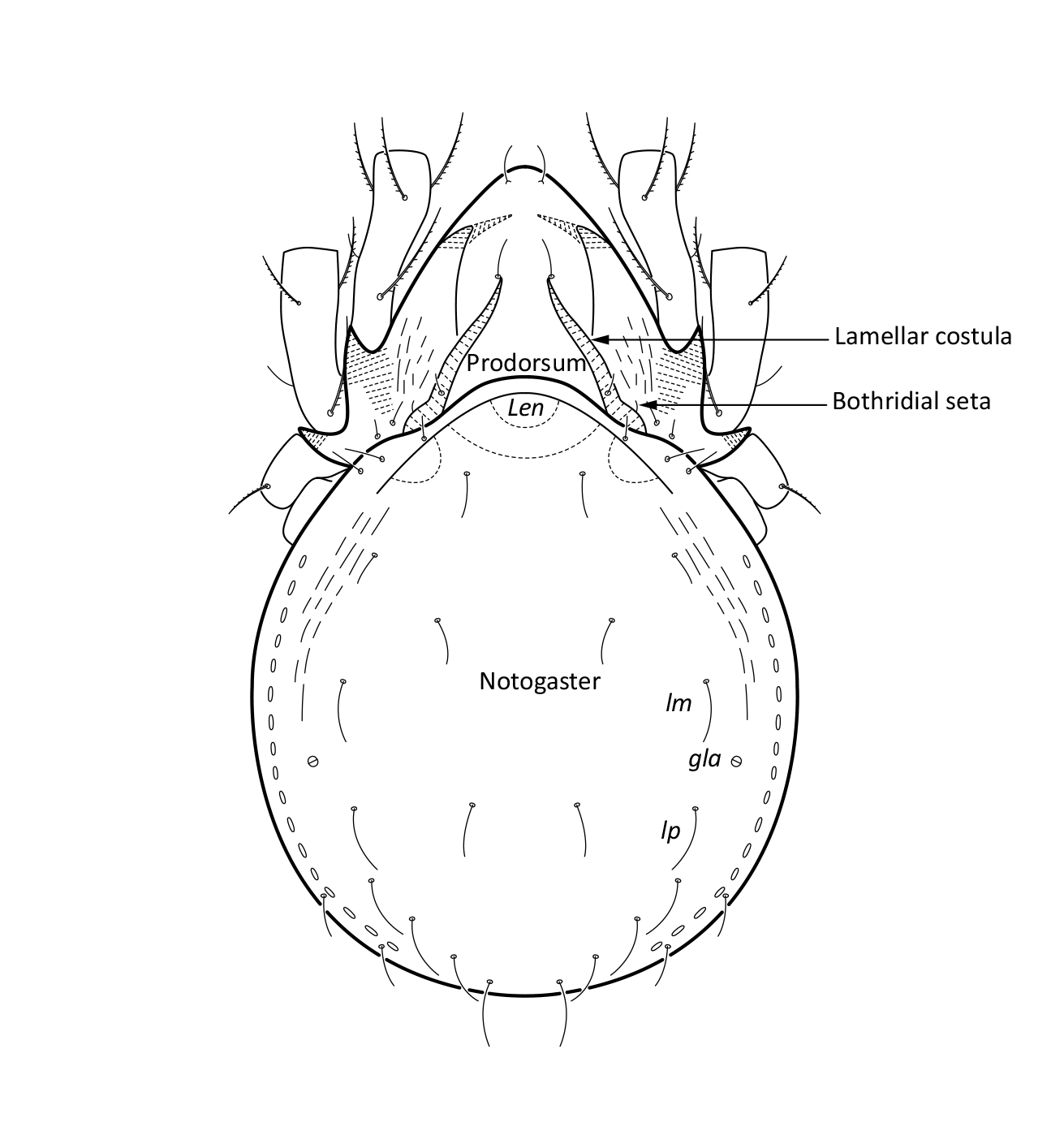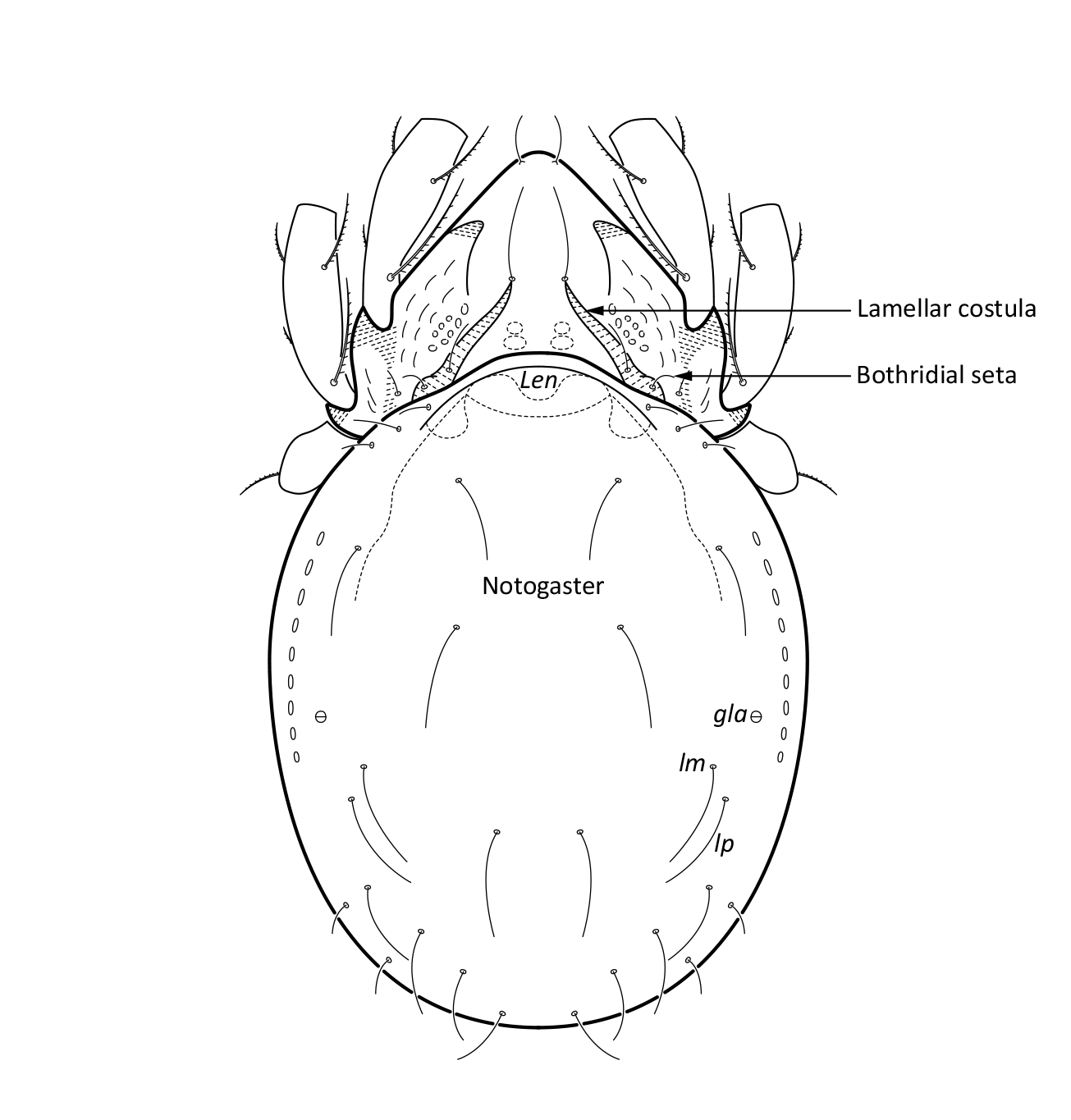Hydrozetes lacustris
Hydrozetes lacustris is a common species found in peatlands. It reproduces under water and all developmental stages live submerged. All Hydrozetes species are aquatic. They are very similar to each other as adults and can easier be identified as juveniles.
- Innhold
- Description
- Look-alikes
- Biology
- Ecology
Description
Adult: The length of the body is 450–547 µm and the width is 298–346 µm. Like all species of Hydrozetes it has oval shape, it is brown, with rather long legs. In the front of the notogaster there is an elevated structure, called lenticults (Len). Prodorsum is triangular, with a pair of narrow lamellar costulae, which are structures similar to lamellae, but without a projecting edge or cusp (Fig. 1). The bothridial seta of Hydrozetes lacustris is setiform and short, and the notogaster has 13 pairs of short setae. The notogastral seta lm is situated in front of the opisthosomal gland opening (gla) (marked in Fig. 1) (Weigmann 2006, Seniczak et al. 2007).
Juvenile stages: Larva: body length 231 µm, width 141 µm. Protonymph: body length 303 µm, width 171 µm. Deutonymph: body length 378 µm, width 235 µm. Tritonymph: body length 498 µm, width 290 µm. Juveniles are flesh colored. The nymphs are boat shaped. Prodorsum is triangular, porose, with lateral part slightly wrinkled. The bothridial seta is long and setiform. Other setae on the prodorsum are short. Gastronotum has small pits in the central part, while frontal and lateral parts are slightly wrinkled. The gastronotal seta lm is short and thin and situated medially to the opisthosomal gland opening (gla), and the gastronotal seta lp is very long and thick (Fig. 2) (Seniczak et al. 2007).
Fig. 1. Dorsal view of Hydrozetes lacustris, adult; Len – lenticulus, lm, lp – notogastral setae, gla – opisthosomal gland opening.
Fig. 2. Dorsal view of Hydrozetes lacustris, juvenile (tritonymph).
Look-alikes
Hydrozetes lacustris is similar to Hydrozetes octosetosus Willmann, 1932; the latter species was even treated as a synonym of the former species. The species differ by several morphological characters on both adults and juveniles, including the length and position of the notogastral seta lm in the adult. In Hydrozetes lacustris notogastral seta lm is short and situated in front of the opisthosomal gland opening (gla), while in Hydrozetes octosetosus this seta is rather long and situated posteriorly to gla. In the nymphs of Hydrozetes lacustris seta lm is short and thin and situated medially to gla, while in the nymphs of Hydrozetes octosetosus seta lm is very long and thick and situated posterior to gla (Seniczak et al. 2007).
Fig. 4. Dorsal view of Hydrozetes octosetosus, adult; Len – lenticulus, lm, lp – notogastral setae, gla – opisthosomal gland opening.
Fig. 5. Dorsal view of Hydrozetes octosetosus, juvenile (tritonymph).
Biology
The species is parthenogenetic, that is, females are produced from unfertilized eggs. It reproduces in late summer (gravid females were found in July and September) (Popp 1962). Regarding its feeding preferences, it belongs to predators or scavengers (Lehmitz and Maraun 2016).
Hydrozetes lacustris has interesting adaptations to aquatic life. It can breathe under water and orientate in the water depth with a lenticulus, a structure that serves like an eye. In case of danger, e.g., when attacked by a predator, it can quickly rise in the water column to the surface (Schatz and Behan-Pelletier 2007).
Fig. 3. Dorsal view of Hydrozetes lacustris, juvenile (tritonymph).
Ecology
Hydrozetes lacustris occurs in floating Sphagnum moss in bogs, and in algae in strongly acidic waters. It is the most common and most abundant Hydrozetes species in peatlands. In ponds in Fløyen area and on Ulriken (Bergen, Vestland) it was usually found together with Hydrozetes octosetosus, but in different proportions. In one of the studied ponds Hydrozetes lacustris occured alone and in high density.
Distribution
Hydrozetes lacustris is found in the Holarctic (Subías 2004), that is the northern continents of the world.
Habitat
The species lives in Sphagnum-dominated peatlands and is confined to aquatic, acidic microhabitats (Weigmann and Deichsel 2006).
Findings in Norway
The species was first reported by Sig Thor (1937) from the areas near Oslo. Since then it has been found in many peatlands in Vestland (Seniczak et al. 2007, 2010, 2020), Trøndelag, and Nordland (A. Seniczak, pers. comm. 2023). It was reported in lake sediments at Trettetjørn (Riva-Caballero et al. 2010).
References
Lehmitz R and Maraun M (2016). Small-scale spatial heterogeneity of stable isotopes signatures (15N, 13C) in Sphagnum sp. transfers to all trophic levels in oribatid mites. Soil Biology and Biochemistry 100, 242–251. doi.org/10.1016/j.soilbio.2016.06.005
Popp E (1962). Semiaquatile Lebensräume (Bülten) in Hoch- und Niedermooren. 2 Teil. Die Milbenfauna. Internationale Revue der gesamten Hydrobiologie, 47(4), 533–579.
Riva-Caballero A, Birks HJB, Bjune AE, Birks HH and Solhøy T (2010). Oribatid mite assemblages across the tree-line in western Norway and their representation in lake sediments. Journal of Paleolimnology, 44, 361–374. doi.org/10.1007/s10933-010-9411-y
Schatz H and Behan-Pelletier V (2007). Global diversity of oribatids (Oribatida: Acari: Arachnida). In: Balian EV, Lévêque C, Segers H and Martens K (eds) Freshwater Animal Diversity Assessment. Developments in Hydrobiology, vol 198. Springer, Dordrecht. Doi.org/10.1007/978-1-4020-8259-7_35
Seniczak A, Seniczak S, Iturrondobeitia JC, Solhøy T and Flatberg KI (2020). Diverse Sphagnum mosses support rich moss mite communities (Acari, Oribatida) in mires of western Norway, Wetlands, 40, 1339–1351. doi.org/10.1007/s13157-019-01236-w
Seniczak A, Solhøy T, Seniczak S and Riva-Caballero A (2010). Species composition and abundance of the oribatid fauna (Acari, Oribatida) at two lakes in the Fløyen area, Bergen, Norway. Biological Letters, 47(1), 11–19. doi.org/10.2478/v10120-009-0014-0
Seniczak S, Solhøy T and Seniczak A (2007). Systematic status of Hydrozetes octosetosus Willmann, 1932 (Acari: Oribatida: Hydrozetidae) in the light of ontogenetic and ecological studies. Journal of Natural History, 41(33–36), 2081–2098. doi.org/10.1080/00222930701535353
Subías LS (2004). Listado sistemático, sinonímico y biogeográfico de los ácaros oribátidos (Acariformes, Oribatida) del mundo (excepto fósiles). Graellsia 60 (número extraordinario), 3–305.
Thor S (1937). Übersicht der norwegischen Cryptostigmata mit einzelnen Nebenbemerkungen. Nyt Magazin for Naturvidenskaberne, 77(1), 275–307.
Weigmann G (2006). Hornmilben (Oribatida). Die Tierwelt Deutschlands. 520 pp. Vol. 76, Goecke and Evers, Keltern.
Weigmann G and Deichsel R (2006). Acari: Limnic Oribatida. [In:] Chelicerata: Araneae, Acari. I. Süßwasserfauna von Mitteleuropa 7/2-1, R. Gerecke (ed.), Spektrum München, 89–112.





